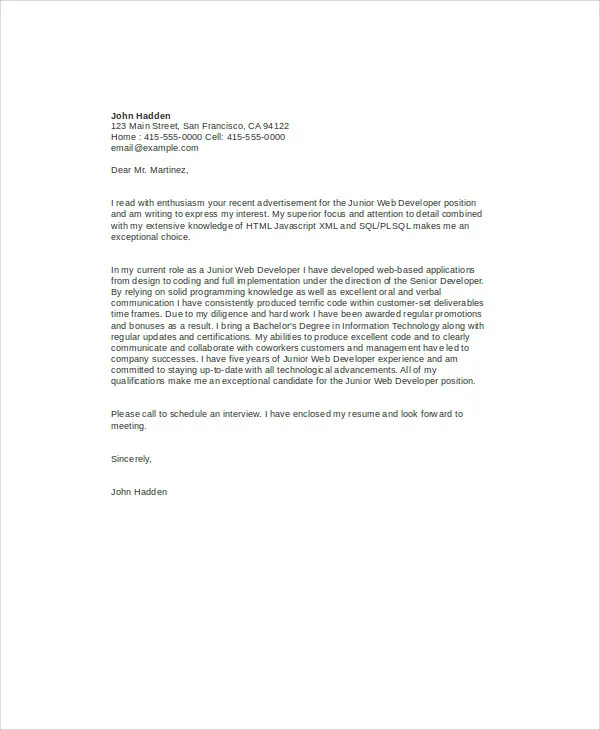Web Developer Cover Letter Guide Overview
In the competitive field of web development, a well-crafted cover letter can significantly increase your chances of landing your dream job. This comprehensive guide provides step-by-step instructions and valuable insights into creating a compelling web developer cover letter that captures the attention of hiring managers and showcases your skills, experience, and passion for the field. A strong cover letter is not merely a formality; it’s your opportunity to make a lasting first impression and set yourself apart from the competition. It allows you to demonstrate your understanding of the role, your enthusiasm for the company, and your ability to communicate effectively. This guide is designed to equip you with the knowledge and tools necessary to write a cover letter that gets you noticed and helps you take the next step in your web development career.
Understanding the Purpose of a Cover Letter
The primary purpose of a cover letter is to introduce yourself to a potential employer and to express your interest in a specific job. It provides context to your resume, allowing you to elaborate on your qualifications, highlight relevant experiences, and demonstrate your personality and communication skills. Think of your cover letter as a personal sales pitch, where you sell yourself as the ideal candidate for the position. It’s your chance to tell your story, explain your career goals, and show why you’re the perfect fit for the company and the role. Understanding the purpose of a cover letter is the first step in crafting an effective one, making sure it aligns with the job description and the company’s values.
Why a Cover Letter Matters for Web Developers
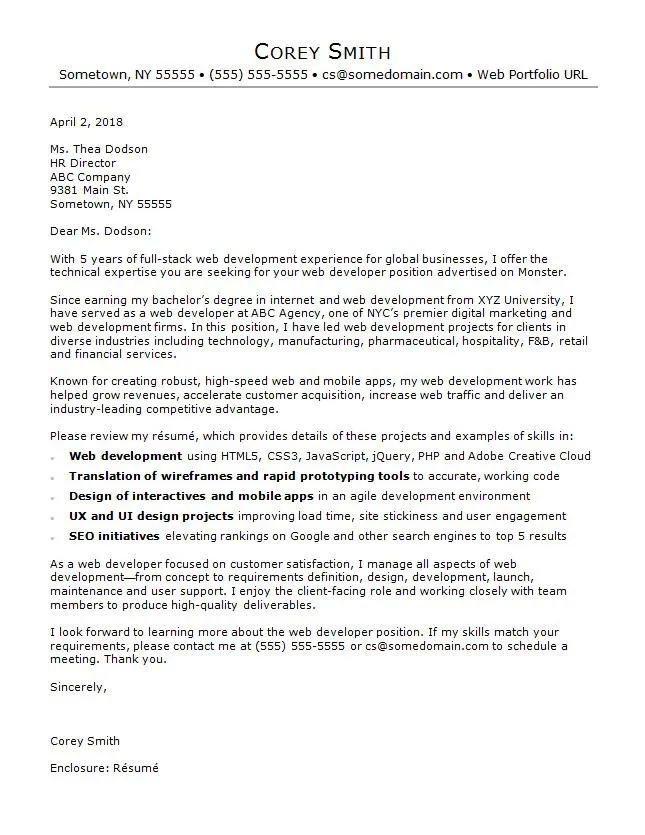
While your resume provides a snapshot of your technical skills and experience, a cover letter allows you to showcase your soft skills, your personality, and your passion for web development. For web developers, a cover letter is particularly important because it allows you to demonstrate your ability to communicate technical concepts clearly and concisely. It also provides a space to highlight your problem-solving abilities, your creativity, and your understanding of the latest web development trends. In a field where communication and collaboration are key, a well-written cover letter can set you apart by proving you can articulate your ideas and work effectively with others. It shows that you’re not just a skilled coder, but a well-rounded professional.
Essential Components of a Web Developer Cover Letter
Contact Information and Salutation
Start your cover letter with your contact information, including your name, phone number, email address, and optionally, your LinkedIn profile or personal website URL. This ensures the hiring manager can easily reach you. Following your contact information, include the date and the hiring manager’s name and title, if available. Addressing the hiring manager by name shows that you’ve done your research and are genuinely interested in the position. If the name is not available, use a professional salutation such as “Dear Hiring Manager” or “Dear [Company Name] Team.” Using the correct salutation sets a professional tone right from the start.
Opening Paragraph Hook
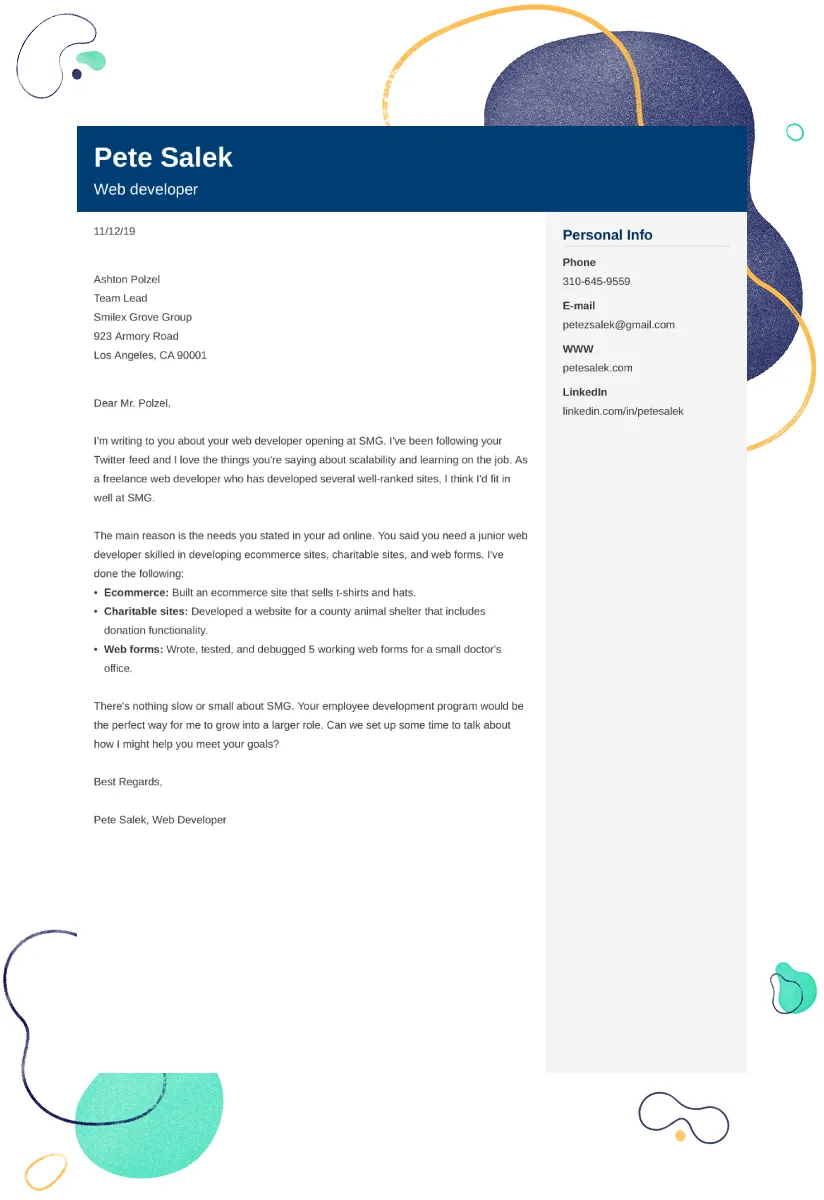
The opening paragraph is your chance to grab the reader’s attention. Instead of a generic opening, start with a hook that immediately demonstrates your enthusiasm and your understanding of the role. Mention the specific job title you are applying for and briefly state why you are interested in the position and the company. This could be a specific project, a company value that resonates with you, or a problem you’re excited to help solve. A strong opening paragraph will make the hiring manager want to read more about your qualifications and experience. Avoid generic phrases and focus on showcasing your unique interest in the specific opportunity.
Highlighting Skills and Experience
This is where you showcase your relevant skills and experience. Carefully review the job description and identify the key skills and requirements the employer is looking for. Then, in your cover letter, highlight the skills you possess that align with those requirements. Provide specific examples of how you have used those skills in previous projects or roles. Use action verbs to describe your accomplishments and quantify your achievements whenever possible. For example, instead of saying “Developed websites,” say “Developed and deployed three responsive websites, resulting in a 20% increase in user engagement.” This section is your chance to demonstrate your qualifications and prove you are the ideal candidate for the role.
Showcasing Projects and Achievements
Go beyond simply listing your skills; provide tangible examples of your accomplishments. Describe specific projects you’ve worked on, emphasizing your role, the technologies you used, and the outcomes you achieved. If possible, quantify your achievements with data. Did you improve website loading times? Did you increase user engagement or conversions? Did you reduce development costs? Showcasing your projects and achievements demonstrates your ability to deliver results and adds credibility to your claims. Include links to your portfolio or live project demos, if applicable, to allow the hiring manager to see your work firsthand. This is your chance to shine by sharing how your skills have made a real-world impact.
Tailoring Your Cover Letter
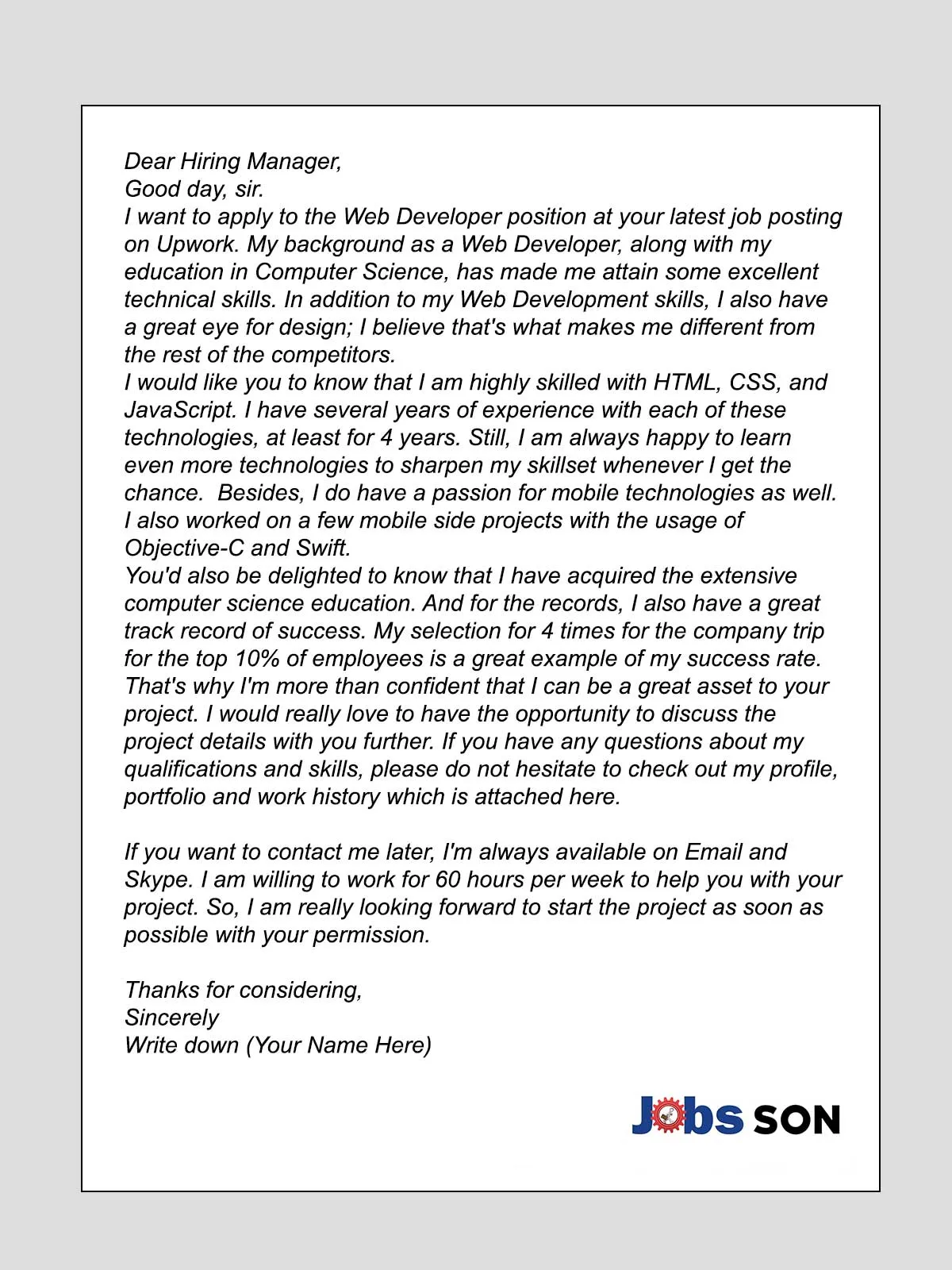
One of the most important steps in writing a successful cover letter is tailoring it to each specific job application. Avoid using a generic cover letter template. Instead, thoroughly research the company and the role, and customize your letter to reflect your understanding of their needs and values. Highlight the specific skills and experiences that are most relevant to the job description. Show how your qualifications align with the company’s requirements. Mentioning the company by name and referencing their specific projects or initiatives demonstrates your genuine interest and attention to detail. Tailoring your cover letter shows you’ve invested the time and effort to understand the opportunity and makes you a more attractive candidate.
Closing and Call to Action
In your closing paragraph, reiterate your interest in the position and express your enthusiasm for the opportunity. Summarize your key qualifications and why you are a good fit for the role. End with a clear call to action. State that you are eager to discuss your qualifications further in an interview and are available at their earliest convenience. Thank the hiring manager for their time and consideration. A strong closing will leave a lasting positive impression and encourage the hiring manager to take the next step in the hiring process.
Formatting and Design Best Practices
Font Choice and Readability

The format and design of your cover letter are just as important as the content. Choose a professional and easy-to-read font, such as Arial, Calibri, or Times New Roman, with a font size between 10 and 12 points. Use consistent formatting throughout the document, including the font, margins, and spacing. Ensure your letter has clear headings, bullet points, and ample white space to break up the text and make it visually appealing. Readability is crucial; the hiring manager should be able to quickly scan and understand your key qualifications. A well-formatted cover letter shows that you pay attention to detail and take pride in your work.
Using Keywords Effectively
To increase your chances of getting noticed, incorporate relevant keywords from the job description into your cover letter. This helps applicant tracking systems (ATS) identify your qualifications and also shows that you understand the requirements of the role. However, avoid keyword stuffing, which can make your letter sound unnatural and forced. Instead, seamlessly integrate keywords into your descriptions of skills, experience, and achievements. Use a balance of keywords and natural language to effectively convey your qualifications and showcase your suitability for the position. Focus on the most important keywords and integrate them naturally into your writing.
Proofreading and Editing
Before submitting your cover letter, carefully proofread and edit it for any typos, grammatical errors, or formatting inconsistencies. Errors can undermine your credibility and suggest a lack of attention to detail. Use a grammar checker tool and ask a friend or colleague to review your letter as well. A fresh pair of eyes can often catch mistakes that you might miss. Ensure that your letter is well-written, clear, and concise. Proofreading and editing are critical steps in presenting a professional and polished cover letter that accurately represents your skills and experience.
Examples of Strong Web Developer Cover Letters
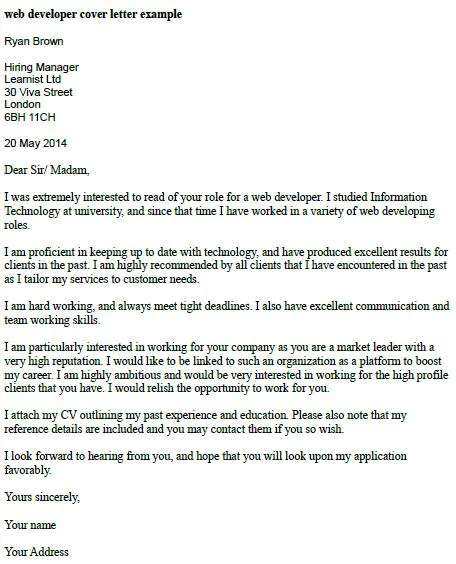
Example 1: Junior Web Developer
In this example, the junior web developer highlights their skills and enthusiasm for the role. The cover letter includes a clear opening statement, mentions specific projects, and showcases relevant skills. It also highlights their educational background, and any internships or volunteer experience. This example demonstrates how to effectively target a junior-level position and highlight potential without extensive experience.
Example 2: Experienced Web Developer
This cover letter example caters to an experienced web developer. It concentrates on the candidate’s extensive experience, technical expertise, and leadership skills. It showcases accomplishments with quantifiable results, and includes project details. It emphasizes the impact of past projects and provides a clear call to action. The letter is written to appeal to a senior-level role and to demonstrate the experience needed.
Example 3: Cover Letter for a Specific Job
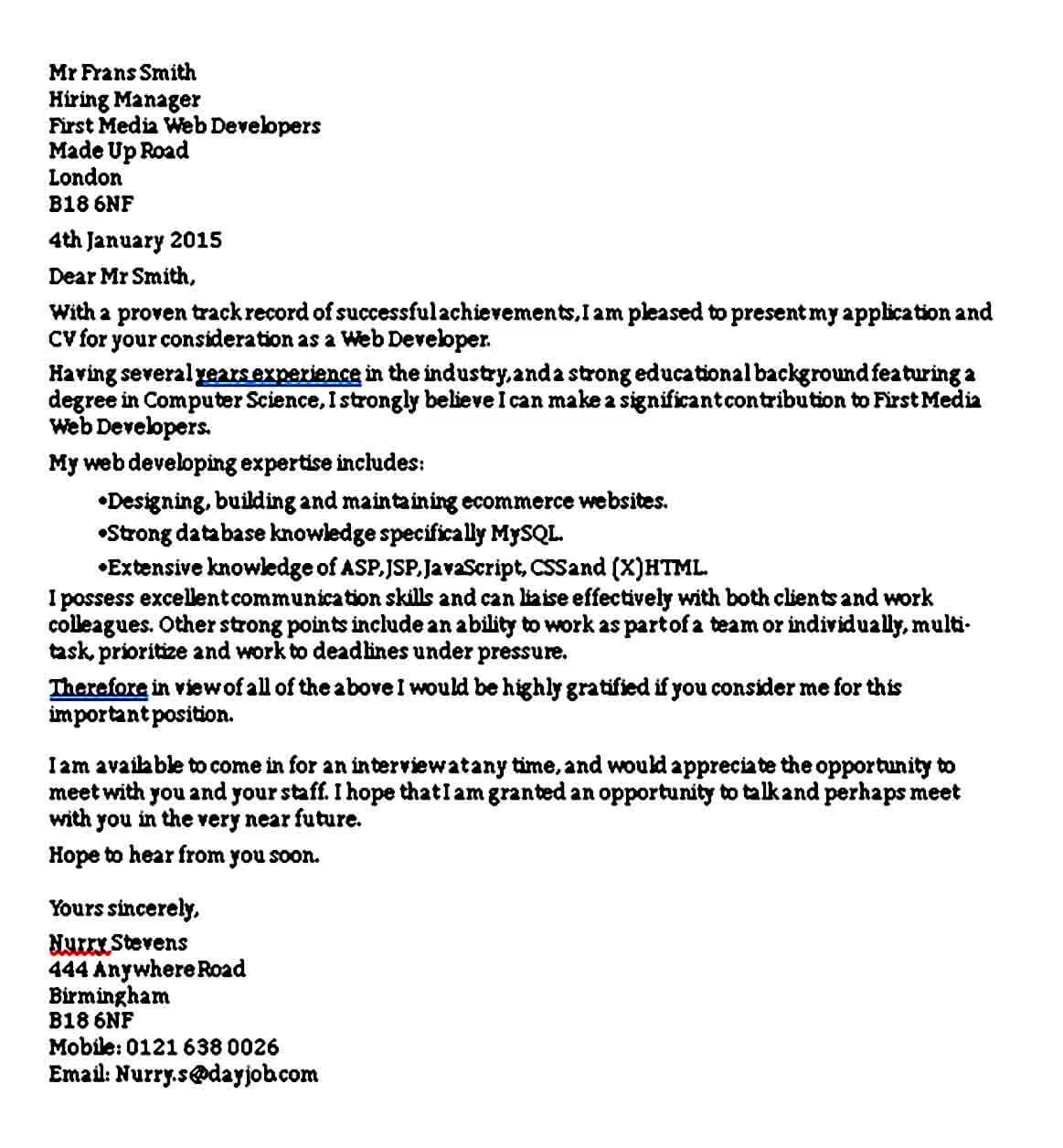
The third example is tailored to a very specific job. The letter highlights the company’s projects and mission, and how the applicant’s skills can benefit the company. The letter emphasizes the job requirements and is customized for the position and company. The candidate highlights the alignment between their qualifications and the company’s needs. The letter includes specific technical skills, a demonstration of how they can use the skills, and what they can contribute to the team.
Common Mistakes to Avoid
Generic Cover Letters
One of the biggest mistakes is using a generic cover letter. These letters lack personalization and demonstrate a lack of interest in the specific role or company. Generic cover letters are easily recognizable by hiring managers and often result in rejection. To avoid this, always tailor your letter to the specific job description and company. Show that you’ve done your research and that you understand the role and the company’s needs. Personalize your opening paragraph and highlight your relevant skills and experiences in relation to the job requirements.
Typos and Grammatical Errors
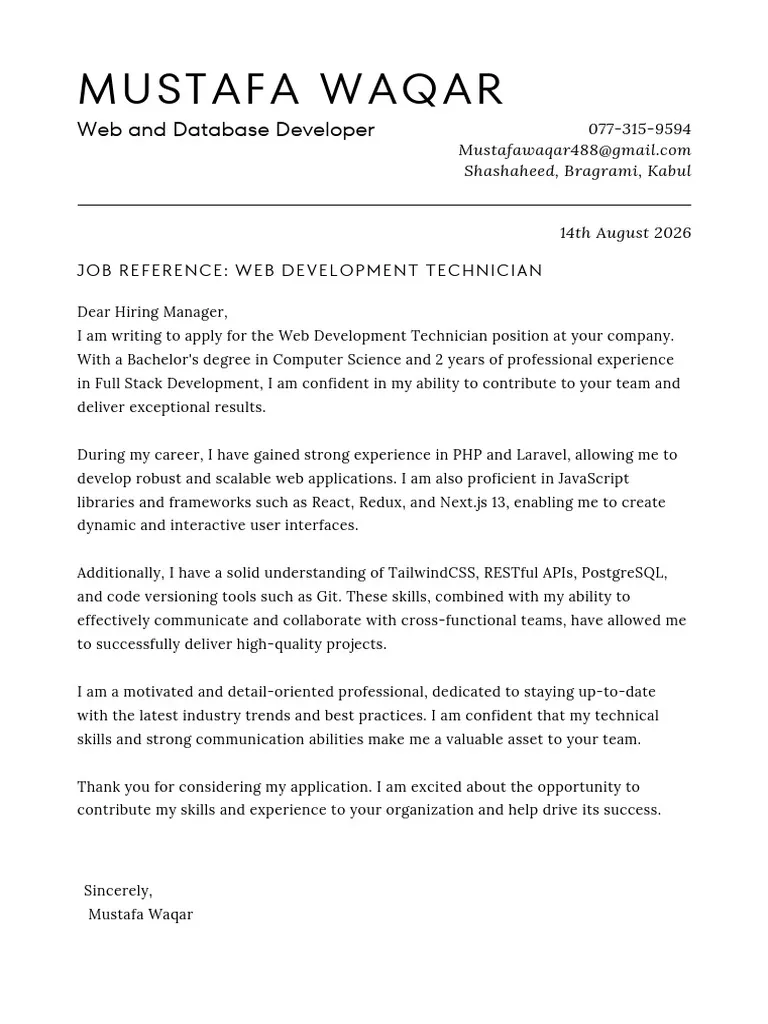
Typos and grammatical errors can instantly damage your credibility. These errors can create the impression that you are careless and inattentive to detail. Always proofread your cover letter carefully before submitting it, and use a grammar checker tool to catch any mistakes. Ask a friend or colleague to review your letter for you, as a fresh pair of eyes can often spot errors that you might miss. A polished and error-free cover letter will demonstrate your professionalism and attention to detail, which are crucial in the web development field.
Not Tailoring to the Job Description
Failing to tailor your cover letter to the job description is another common mistake. Generic cover letters don’t address the specific requirements and expectations of the role. To avoid this, carefully review the job description and identify the key skills, experiences, and qualifications the employer is looking for. Highlight the aspects of your background that directly align with these requirements. Use keywords from the job description to show that you possess the necessary skills and understanding of the role. Demonstrating that you are a good fit for the role will increase your chances of getting an interview.
Additional Tips for Web Developers
Using a Portfolio Link
As a web developer, your portfolio is one of your most valuable assets. Always include a link to your portfolio in your cover letter. Your portfolio allows the hiring manager to see your work firsthand and evaluate your skills and creativity. Make sure your portfolio is up-to-date and showcases your best projects. Ensure that your portfolio website is well-designed, easy to navigate, and mobile-friendly. Provide descriptions of your projects, highlighting your role, the technologies used, and the results achieved. A strong portfolio is a powerful tool for demonstrating your abilities and making a positive impression.
Mentioning Specific Technologies
When describing your skills and experience, be specific about the technologies you know and the languages you are proficient in. Include the specific frameworks, libraries, and tools you have used. Mentioning specific technologies shows that you have the technical knowledge required for the role. For example, instead of saying “Experience with web development,” say “Proficient in HTML, CSS, JavaScript, React, and Node.js.” Use the job description to determine which technologies are most relevant and highlight those in your cover letter. This helps demonstrate your understanding of the role and the company’s technology stack.
Expressing Enthusiasm
Let your passion for web development shine through in your cover letter. Express your enthusiasm for the role, the company, and the web development field in general. Share your excitement for the opportunity to contribute to their projects and to learn and grow. Mentioning specific company projects you admire or company values that resonate with you demonstrates genuine interest and makes you a more memorable candidate. Showing that you’re passionate about your work can make a strong impression and make you stand out from other applicants.
In conclusion, writing a successful web developer cover letter involves understanding its purpose, highlighting relevant skills, and tailoring it to each specific job application. By following the guidelines in this comprehensive guide, you can create a compelling cover letter that showcases your skills, experience, and passion for web development. Always proofread and edit your letter carefully. Remember to include a link to your portfolio, mention specific technologies, and express your enthusiasm for the opportunity. A well-crafted cover letter is a valuable tool that can significantly increase your chances of landing your dream job. Good luck with your job search!
